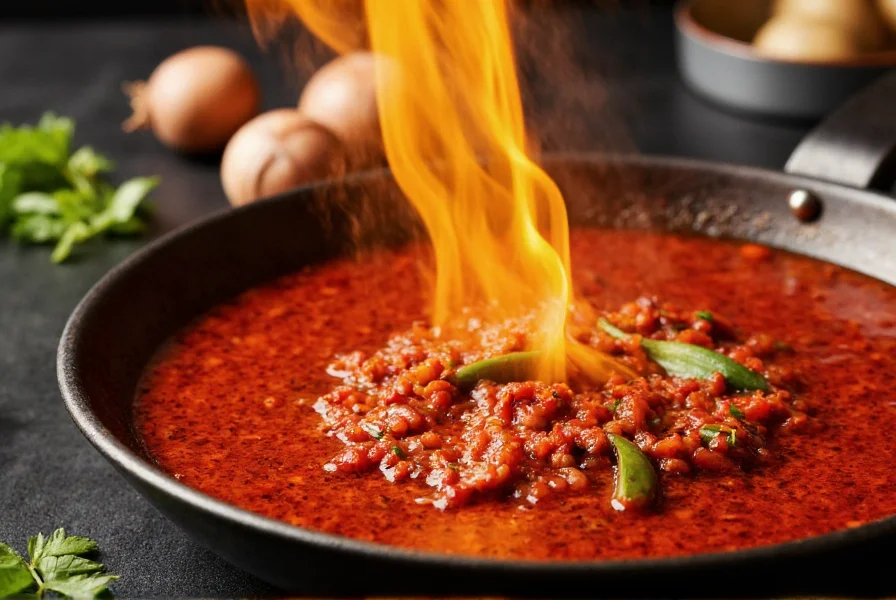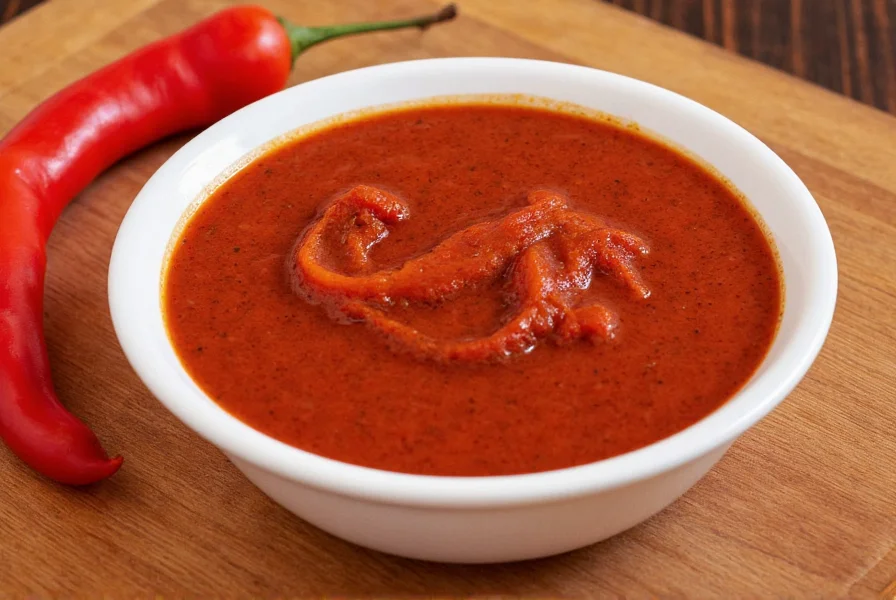Understanding chili paste is essential for anyone looking to elevate their cooking with authentic Asian, Latin American, or global flavors. This versatile ingredient forms the flavor foundation in countless cuisines worldwide, from Thai curries to Mexican salsas. Unlike fresh chilies that can vary in heat level, quality chili paste offers consistent spiciness and depth that transforms ordinary dishes into restaurant-quality meals.
What Exactly Is Chili Paste?
Chili paste refers to any thick preparation of ground or pureed chili peppers combined with complementary ingredients. The paste consistency comes from the high ratio of solid chili matter to liquid, typically achieved through grinding fresh chilies or reconstituting dried ones. Traditional production methods involve pounding chilies with mortar and pestle, though modern versions use food processors.
The magic of chili paste lies in its concentrated flavor profile. While fresh chilies provide heat, the fermentation or cooking process in paste preparation develops complex umami notes, acidity, and sweetness that fresh peppers alone can't deliver. This makes chili paste not just a heat source but a complete flavor enhancer.
Major Types of Chili Paste Compared
| Type | Origin | Key Ingredients | Heat Level | Best Uses |
|---|---|---|---|---|
| Sriracha | Thailand/Vietnam | Red jalapeños, garlic, sugar, vinegar | Moderate (2,200 SHU) | Dipping sauce, sandwiches, stir-fries |
| Gochujang | Korea | Fermented soybeans, glutinous rice, red pepper flakes | Moderate with sweetness | BBQ marinades, stews, bibimbap |
| Sambal Oelek | Indonesia | Pure ground red chilies, vinegar, salt | High (50,000-100,000 SHU) | Curry bases, dipping sauces, chili oil |
| Harissa | Tunisia/North Africa | Roasted red peppers, Baklouti peppers, garlic, spices | Moderate to High | Tagines, roasted vegetables, couscous |
| Chili Garlic Paste | China/Thailand | Red chilies, garlic, vinegar, salt | Medium-High | Stir-fries, noodle dishes, dumpling sauce |
Flavor Profiles and Heat Characteristics
Chili pastes vary dramatically in flavor complexity beyond simple heat. Understanding these differences helps you select the right paste for your dish:
Heat measurement: Most commercial chili pastes range from 2,000-50,000 Scoville Heat Units (SHU), though artisanal versions can exceed 100,000 SHU. The heat level depends on chili variety, ripeness, and whether seeds/membranes are included.
Flavor dimensions: Beyond capsaicin heat, quality chili paste delivers:
- Umami depth from fermentation or added ingredients like soybeans
- Acidity from vinegar or natural fermentation
- Sweetness from natural sugars or added sweeteners
- Garlicky notes in many Asian varieties
- Smoky undertones in roasted pepper varieties
Practical Culinary Applications
Mastering chili paste usage transforms your cooking. Here's how to incorporate it effectively:
Building Flavor Foundations
Add 1-2 teaspoons of chili paste to hot oil before adding other ingredients. This "blooming" technique releases volatile compounds and integrates the paste into the dish's flavor base. For Thai curries, this step with red or green curry paste (which contains chili paste) is essential for authentic flavor.

Dosage Guidelines
Start with small amounts and adjust to taste:
- Subtle heat: 1/4-1/2 teaspoon per serving
- Moderate kick: 1-2 teaspoons per serving
- Intense heat: 1 tablespoon+ per serving
Remember that heat perception increases as a dish sits, so allow 15-20 minutes after adding chili paste before final seasoning.
Global Recipe Applications
Chili paste shines across cuisines:
- Asian cooking: Stir 1 tablespoon gochujang into marinades for Korean BBQ
- Mexican dishes: Mix chipotle paste into adobo sauce for authentic depth
- Middle Eastern cuisine: Blend harissa with yogurt for a quick dip
- Western fusion: Add sriracha to mayo for gourmet burgers
Smart Substitutions When Chili Paste Is Unavailable
Running out of chili paste doesn't mean sacrificing flavor. Try these alternatives:
- For sriracha: Combine 1 part tomato paste, 1 part ketchup, 1 minced garlic clove, and 1/4 teaspoon cayenne pepper
- For gochujang: Mix 2 parts miso paste, 1 part red pepper flakes, 1/2 part honey, and rice vinegar to consistency
- For sambal oelek: Blend 3 fresh red jalapeños (seeds included) with 1 teaspoon vinegar and 1/4 teaspoon salt
When substituting, remember that pastes provide concentrated flavor without excess liquid, so adjust other liquids in your recipe accordingly. For best results in long-cooked dishes, add substitutes later than you would authentic paste.
Storage and Shelf Life Optimization
Proper storage maintains chili paste quality and safety:
- Unopened: Store in cool, dark pantry for 1-2 years
- Opened: Refrigerate immediately; most last 6-12 months
- Freezing: Portion into ice cube trays, then transfer to freezer bags for 12-18 month storage
Signs of spoilage include mold growth, significant color change, or off odors. High-quality chili paste may separate naturally—simply stir before use. Always use clean utensils to prevent contamination.
Buying Guide: Selecting Quality Chili Paste
When choosing chili paste, consider these factors:
- Ingredient simplicity: Top-quality pastes list minimal ingredients (chilies, salt, vinegar, maybe garlic)
- Avoid fillers: Steer clear of products with excessive sugar, thickeners, or artificial preservatives
- Texture check: Should be smooth but contain visible chili particles
- Color authenticity: Vibrant red indicates fresh chilies; dull brown suggests age or poor processing
For authentic flavors, seek brands from the paste's country of origin. Korean gochujang should contain glutinous rice, while genuine sambal oelek lists only chilies, salt, and vinegar. Read labels carefully—many "chili sauces" are actually thin liquids unsuitable as paste substitutes.
Common Mistakes to Avoid with Chili Paste
Even experienced cooks make these errors:
- Adding at the end of cooking: Heat-sensitive compounds burn off; add early for integrated flavor
- Using as direct fresh chili replacement: Adjust liquid content in recipes (1 tablespoon paste ≈ 1-2 fresh chilies + 1 tsp liquid)
- Ignoring regional differences: Thai chili paste differs significantly from Mexican versions
- Overestimating heat tolerance: Start with half the recommended amount and adjust
Professional chefs recommend keeping multiple chili paste varieties on hand for different applications rather than relying on one "all-purpose" option. Each type brings unique flavor dimensions that can't be perfectly replicated.
Conclusion: Mastering Chili Paste in Your Kitchen
Chili paste represents one of cooking's most versatile flavor enhancers when understood and used properly. By recognizing the differences between varieties, understanding their unique flavor profiles, and applying them at the right stage of cooking, you can dramatically elevate your dishes. Remember that quality matters—invest in authentic products from reputable sources for the best results. Whether you're making a quick weeknight stir-fry or an elaborate curry, the right chili paste can transform ordinary ingredients into extraordinary meals.
Frequently Asked Questions
What's the difference between chili paste and chili sauce?
Chili paste has a thick, concentrated consistency with minimal liquid content, while chili sauce is thinner and more pourable. Paste provides intense flavor without adding excess moisture to dishes, making it ideal for marinades and as a flavor base. Sauce works better for finishing dishes or as a dipping condiment. The ingredient composition also differs—authentic pastes contain primarily chilies and salt, while sauces often include additional liquids and sweeteners.
Can I make chili paste at home?
Yes, homemade chili paste is simple to make. For basic red chili paste, blend 1 cup fresh red chilies (stems removed), 3 garlic cloves, 1 teaspoon salt, and 2 tablespoons vinegar until smooth. Adjust vinegar for desired consistency. For fermented paste, combine equal parts ground chilies and salt, pack into a jar, and let ferment at room temperature for 1-3 weeks before refrigerating. Homemade versions lack preservatives, so use within 2-3 weeks or freeze for longer storage.
Is chili paste gluten-free?
Most traditional chili pastes are naturally gluten-free as they contain only chilies, salt, vinegar, and sometimes garlic. However, some commercial varieties (particularly Korean gochujang) may contain wheat or barley. Always check labels if you require gluten-free options. For absolute certainty, choose brands specifically labeled gluten-free or make your own using certified gluten-free ingredients.
How spicy is typical chili paste?
Spiciness varies significantly by type. Sambal oelek ranges from 50,000-100,000 Scoville units (moderately hot), while sriracha sits around 2,200 units (mild to medium). Gochujang offers moderate heat with balancing sweetness. Always start with small amounts (1/4-1/2 teaspoon) and adjust to your tolerance. Remember that heat perception increases as dishes cook and sit, so allow time for flavors to develop before adding more.











 浙公网安备
33010002000092号
浙公网安备
33010002000092号 浙B2-20120091-4
浙B2-20120091-4